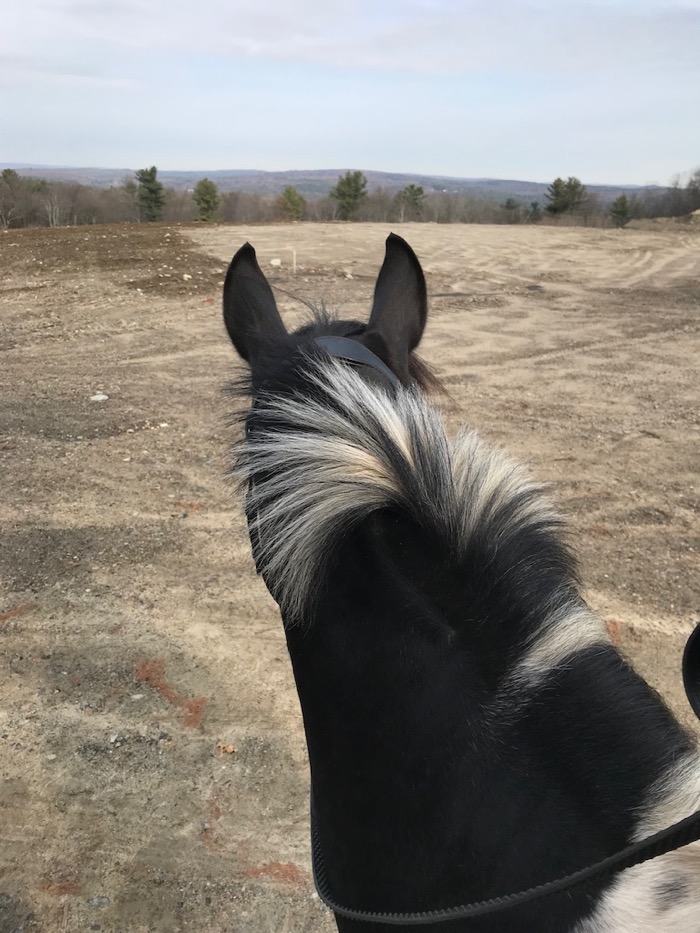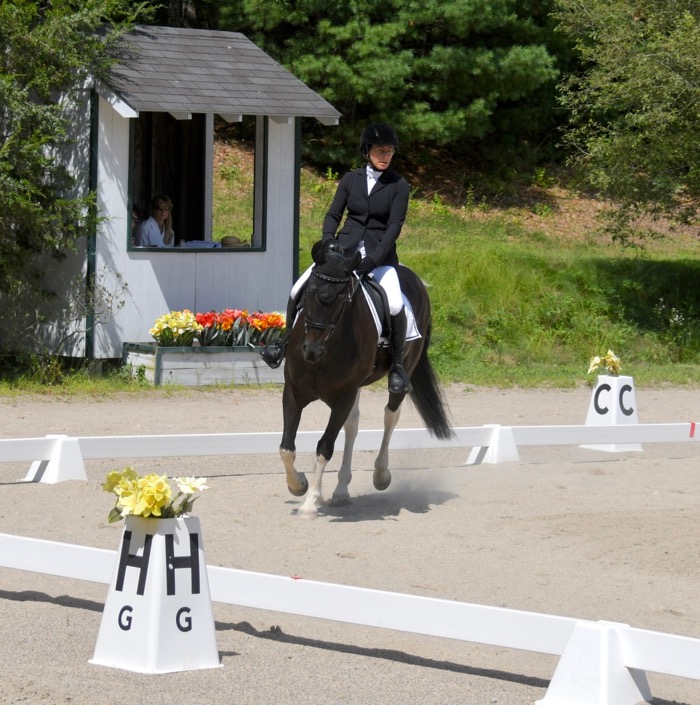Riding instructors talk a lot about aids – how you use your hands, seat and legs – to communicate what you want to the horse. I’d add another aid, and to me it’s at least as important as the others. Your eyes.
Do this. Right now, look to the right. Feel your torso move? A shift in the weight in your pelvis? A drop in a shoulder? If you were sitting on a horse, they’d feel that. Now try this: stop looking at whatever screen you’re reading this on, and focus, really take in the details, of something straight across the room. Did your body go still yet not slack? If you were sitting on a horse, they’d feel that. Where you look, and how you look, takes precedence to the horse over anything you might say out loud, or even how hard you apply the heels of your boots.
Your eyes convey your intent.

When I took the above photo, I was scanning the horizon. We’d never been to this place, and after taking in the scenery, I looked around, trying to find the trail head. Once I did, and focused on the entrance to the woods, Tonka headed that way. It felt like a mind meld, as if I’d done nothing other than to think it, but in reality, he was reading my body language as my intent became clear.
It’s natural, when out on the trail, that we look where we’re going, but in the ring, especially when we’re indoors, we stop using our eyes. We let the wall boards do the work of determining where we go. We get fixated on our rhythm, or our hands, or the carriage of the horse’s head, or whatever else is going on under us, that we don’t look forward. I see this all the time with my students. They get a glazed look in their eyes. Their horses do, too.
I have a student who is a novice rider. There are so many things to say to her about position. But, instead of harping on where her shoulders should be, or how to bend her elbows, etc., etc., I can get much of her body to fall into the correct place and her horse to go forward by simply suggesting where she should focus.
The far end of her indoor arena has a door to the outside (rather like the one in this photo.)

As she comes around the corner, I tell her to look out the door, and to focus on what she sees there, as if she’s going to ride right outside. Her body stills with intent, the horse now knows where to go (without her pulling the reins) and he trots confidently. Before she gets to the corner, I tell her where to look next. They continue on, with purpose. Forward, but not rushed. Once that’s established, then I can tweak her position. But focus always comes first.
This isn’t just for beginner riders. I’m constantly reminding myself to set my sights outward. It’s all too easy to look down at Tonka’s withers, willing him to arch and go into that pretty dressage frame. But when I do that, my hands get restrictive, my legs push but don’t allow, and my weight tips and burdens his forehand. Tonka slows and becomes evasive. This can become a vicious circle – you try to get a bend, the horse hesitates, you force forward, the horse resists with a hollow movement, so you insist in a harsher way. You can tell that this is happening by looking at the rider’s eyes. They become glassy. They reflect the rider’s inward-focused, frustrated place. When that happens, take a deep breath. Walk. Look up and find something to ride towards. Then start again.
Focusing can be difficult! In my lessons I often tell my students to look at me. I hold up my hand. I ask, How many fingers? There’s often laughter as the student says, Three? five? I don’t know! After a few seconds, when they finally focus enough to see my hand clearly, the horse goes straight and willingly. Unfailingly, I get a smile, and an Oh!
When I ride, I imagine that there are lasers beaming out of my eyes, and that they create a path for Tonka and I between two red lines. (Is this weird? Maybe, but it’s very effective!) This is proactive riding. Tonka has only to barely waver off the path for me to notice and make ever-so-slight adjustments to get him back on track.
When I get something right with my riding, it does seem that what underlies it is a broader lesson that applies to life. Look. Focus. Go. Not a bad mantra to live by.



You are so right about the eyes. In Gymkhana, when you’re trying to get around a barrel or pole, you are supposed to turn your head around to focus on the next obstacle. It happens quickly, but as soon as you do, it reminds your horse where you’re going. If you forget, your horse definitely doesn’t turn as snappy, and if you happen to focus on the obstacle, you’re sure to hit it! It’s amazing to see the light go on in people’s eyes when they figure this out.
I always appreciate your comments – gymkhana isn’t something I do, but good riding is universal. Actually, I have a student who started doing barrels this past summer and she asked for my help. She was looking down, into them, and I suggested looking up towards the next turn. She said she saw the other riders looking down. Now I can tell her what you said 🙂
This is so true, and can be applied to so many other circumstances… such as downhill skiing..
My husband, as a beginner skier, was headed down a hill that he found intimidating, and off to the side was one of those snow-making cannons.. he was afraid of hitting it, even though it was not in his path.. and he kept looking at it.. well, he hit the thing. He could have been killed, because he was not in control of his speed.
Ditto to Laura’s comment, in show jumping.. see where the good riders are looking as they jump: at the next jump!
True in life as well.. keep your sight on where you want to go and you will get there!
Great skiing story (and so apt because of the on-going winter olympics.) When I was learning to jump, my instructor always said that you land where you look, and it was true. I ended up on the ground enough times. The Shetland pony who was teaching me, made sure of that!
Great blog, with good information. Will make sure Jess reads and takes it all in. 🙂
Thanks, Jan.
Nice post! I will never forget the first time I read Sally Swift’s book “Centered Riding”, and the A-Ha it gave me on soft eyes. She covers the topic very well too, I actually just purchased it for my daughters who are beginning riders. Definitely recommended reading! Your eyes and how you use them can affect your whole life, well beyond the saddle.
Sally Swift conveyed these concepts in such an accessible way. It’s nice to hear her words are helping the next generation of equestrians.